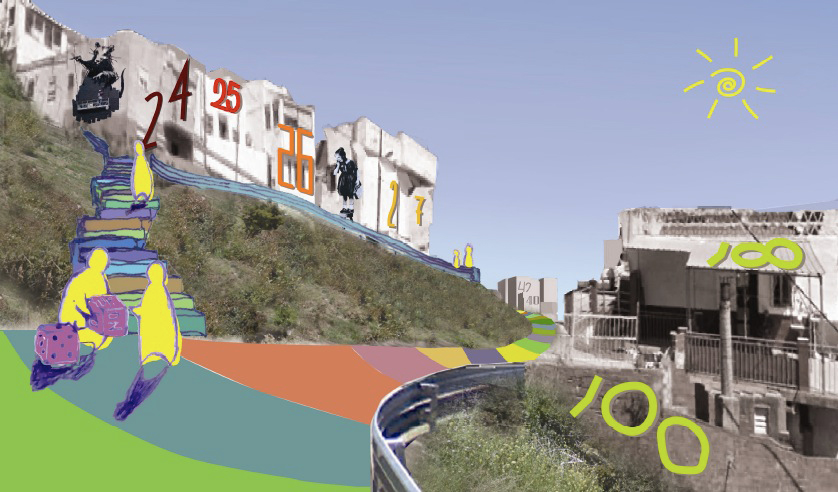 Earlier this month, the masters program held a three-week workshop directed by Giovanna Carnevali in collaboration with UN-HABITAT Training and Capacity Building Branch, Barcelona Department of Urban Planning, and the metropolitan agency Barcelona Regional. The main topic of the workshop was Urban Regeneration, and worldwide examples and procedures were thoroughly reviewed and applied in the case of Torre Baró, a district in the slopes of Barcelona’s hilly outskirts and characterized by a strong historical and ecological context, the growth of informal settlements, and a lack of integration with the city of Barcelona.
Earlier this month, the masters program held a three-week workshop directed by Giovanna Carnevali in collaboration with UN-HABITAT Training and Capacity Building Branch, Barcelona Department of Urban Planning, and the metropolitan agency Barcelona Regional. The main topic of the workshop was Urban Regeneration, and worldwide examples and procedures were thoroughly reviewed and applied in the case of Torre Baró, a district in the slopes of Barcelona’s hilly outskirts and characterized by a strong historical and ecological context, the growth of informal settlements, and a lack of integration with the city of Barcelona.
The area, a mid-20th century priveleged settlement with self-built homes whose residents were forced to leave and land contracts became either too expensive or illegal after it was defined as a garden city in 1953, rapidly fell into disrepair in the 1960s. Since then, the area has undergone various urban revitalization schemes, yet remains disconnected and lacks accesibility to and from Barcelona and its surrounding communities. Furthermore, Torre Baró lies within the context of Barcelona’s newest project, the 16 Gates of Collserola aimed at rearranging and connecting the city and the Collserola Natural Park through 16 green corridors and equipments, thus forming part of a greater urban regeneration plan.


Torre Baró within the context of the 16 Gates of Collserola Park and Barclona
UN-HABITAT was instrumental in providing the students with a solid framework laying out different urban regeneration strategies and case studies. Students had the opportunity of brainstorming, exchanging views and positioning themselves on issues, which ultimately made them realize how complexity becomes an integral factor of any urban regeneration project.
The course had an array of participants in lectures and meetings from different agents involved in the urban planning of Barcelona such as the Technical District Social Mediator, the Chief Planner involved in the master plan for Vallbona, an adjacent quarter to Torre Baró, the Director of Projects from the city department of planning and development, the director of Barcelona’s Metropolitan Agency Willy Muller, and experts on Mobility – Data Gathering and analysis – from the University Pompeu Fabra.

Mobility analysis: 2D visualisation of pedestrians movement
After intensively reviewing and scrutinizing a wide array of urban regeneration plans worldwide (from an extensive range ofreference of papers and case studies developed by UN-HABITAT ) as well as learning from the city department of Planning & Development’s current and future strategies for the city of Barcelona, the students came up with a set of framework questions on regeneration programs and then worked on how to formulate a viable and implementable urban regeneration strategy for Torre Baró.

Student proposals: Image by Ana Livi. Michela Guglielmi. Silvia Aldana. Wan-Ting Chiang. Tomasso Sacconi

Student proposals: Torre Baró a self-sustained attractive community
A stimulating discussion emerged from the different proposals that were presented to the City Council. At the end of the workshop, the students went one step further and came up with a set recommendations for developing a regeneration project for Torre Baró.
Students were enthusiastic throughout the workshop, and acquired a deeper insight into the field of urban regeneration, Torre Baró serving as an excellent and local example of the complexity of the topic and a good starting point for facing the challenges that setting up a regeneration process may encompass.
—————-
This workshop is a collaboration between:



The latest clash occurred in Hotan Prefecture, in the southern part of Xinjiang, whose population is predominantly Uighur. The Uighurs are a Turkic-speaking group sharing many affinities with people across Central Asia, and most follow relatively moderate forms of Sunni Islam. Many Uighurs resent the growing number of Han Chinese people, who have been attracted to Xinjiang by jobs in farming, energy production and mining.